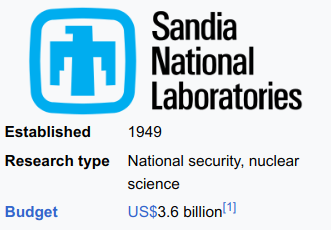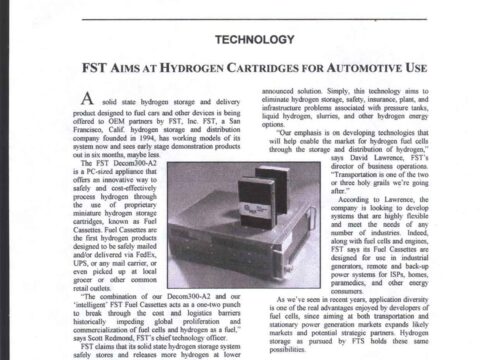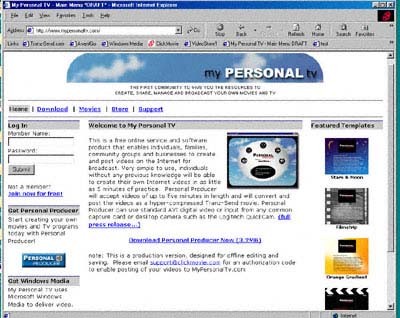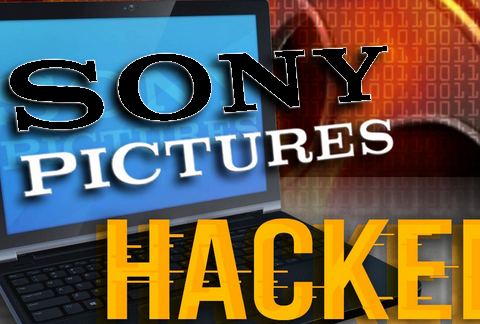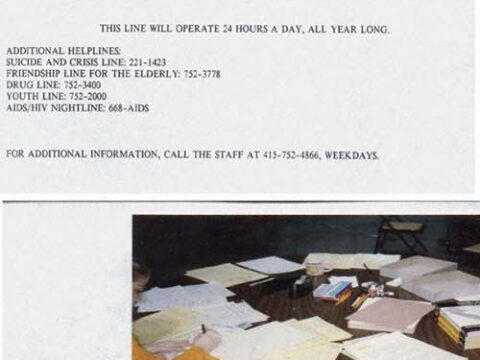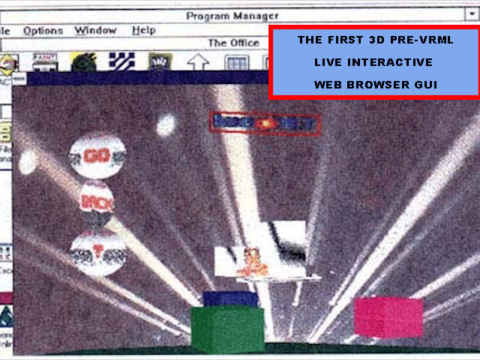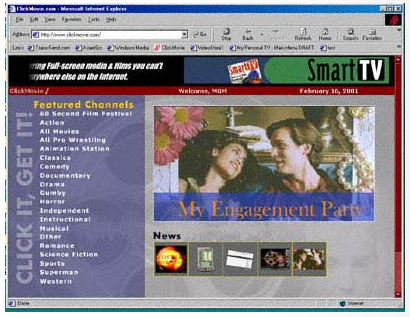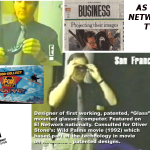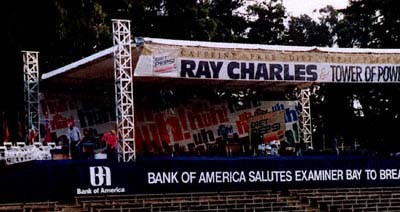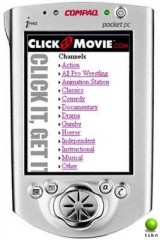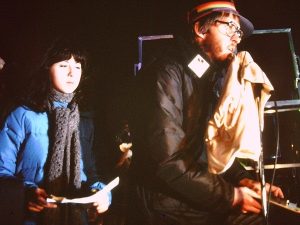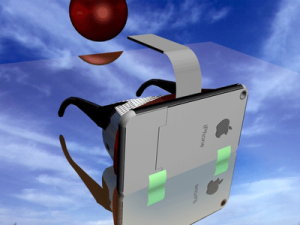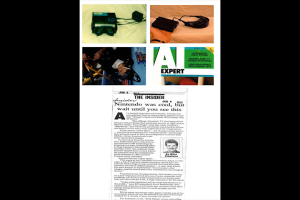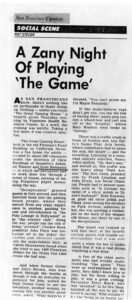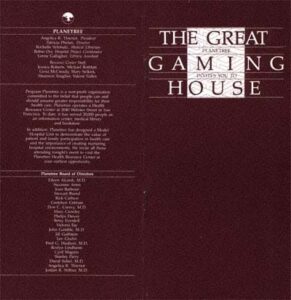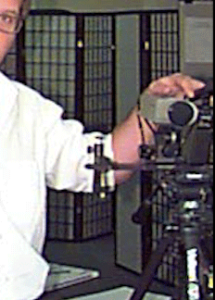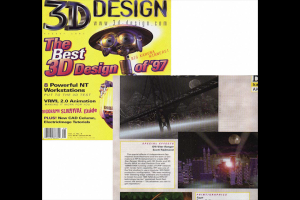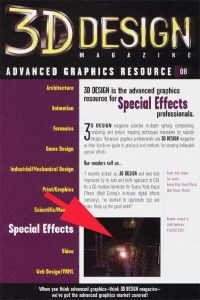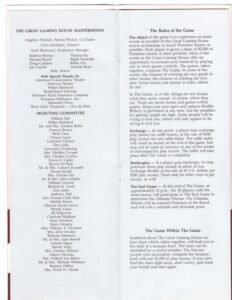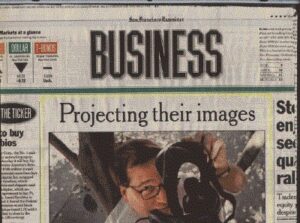WE WERE FIRST
Before Amazon, Netflix, Hulu, Sony Vue, Youtube, Et al…
The TV documentary broadcast by “SILICON VALLEY BUSINESS”, nationwide, proves that we were first to design, patent, build and broadcast before YouTube, Hulu, Vudu, Netflix Streaming, Sony VUE, Napster, Bittorrent or Kontiki existed, we had already delivered Clickmovie.com.
Clickmovie did everything that those later competitors did before any of them even existed. Our team received multiple US patents confirming us as first-to-invent and deliver web video-on-demand. It is a “big deal” because they took billions of dollars out of our pocket by spying on our efforts and copying our technology and business model.
We designed, built and patented some of the first video-on-demand hardware devices. We were the first to present internet video-on-demand to a full Sony Pictures international Board Meeting.
Our work-group is featured in Sony Pictures patent filings.
Our patent filings and NDA’s prove that we designed, engineered, patent filed and produced the touch-screen, MP3 cell phone before Steve Jobs and Apple did and before any internal communications at Apple discuss the “iPhone”.
The patent office has credited us as the first to invent chunks/torrents/bits as a web media broadcast method.
We designed, built and patented some of the first video-on-demand hardware devices.
We designed, built and patented some of the first video-on-demand hardware devices.
Facebook, Yahoo, Google, Netflix, Amazon and other, later, web TV networks have spent millions of dollars to blockade us from getting a jury trial against them for tort-based interference, RICO, infringment, theft and other causes of action.
It turned out that our own Senator’s, Congress-people and Governor OWN Facebook, Netflix (White House Staff work there), Hulu and Google!!!! This helped create THE AMERICAN STOCK ACT, now moving through Congress.
Everytime we sue the copy-cats, they throw millions of dollars of lawyers out to blockade the cases and never allow us to get to Jury Trial.
The other’s did not just have the same idea, they came in and signed secrecy agreements, contracts and emailed about not being able to figure the technology out on their own. Then they just swiped the staff, the code, the architecture and made billions by ripping off the inventor.
Google’s Larry Page had the job of stealing other people’s technology.
The Sony Pictures head of Marketing emailed us that he “did not even know how to work a computer“, then he put his name on a copy of our patent and filed it as his own after we presented, under NDA, to the entire Sony Board and worked with Sony under contract.
The Korean hack of all of Sony Pictures files proved them to be a pack of liars. At Netflix corporate headquarters, the heads of Netflix told us that “It was just easier to mail out DVD’s than to deal with all of that server stuff…” and that they ” really only see streaming as a fringe service for a few nerds..” The San Francisco FBI is now investigating Netflix bosses for various frauds and schemes.
See more at http://www.usinventor.org
SONY PICTURES WORK, RIP-OFF AND HACK CASE TIMELINE
* January 7, 1999 – NDA Executed with Sony Pictures
* January 12, 1999 – NDA executed with Sony Electronics Inc.
* January 1999 – One of multiple NDA’s were signed with SONY prior to the main Sony Board meeting where Scott presented internet video as sole speaker
* In January 1999 – TSBN was asked present to one of the largest corporate meetings Sony had ever called. VP’s were walking in and shaking each others hands and commenting: “oh, I’ve read about you in Variety”” Ira Rubenstein said that they ” had never had so many VP’s and department heads from so many contintents in one room..”. Attendees included but were not limited to most of the top level executives from Sony U.S. and Sony Japan. At this meeting TSBN demonstrated hardware, IP set-up box, portable PDA, software and architecture, under NDA, for an entire VOD internet, cable and satellite IP based digital media technology, all of which Sony is using today. In the building we met Mark Gray, one of the names on the patent and a future advocate of the “Passage”” product from Sony:
Mark C. Gray – Chairman, President & Chief Executive Officer – Kasenna, Inc. Mr. Gray joined Kasenna after a successful tenure with Pluto Technologies, a manufacturer of standard and high definition digital video server products, where he was founder, Chairman, and CEO. He served in this capacity until September 2000 when the company was acquired by Avid Technology, Inc. Prior to that, he served as Chairman, President, and CEO of Chyron Corporation, a publicly traded corporation listed on the New York Stock Exchange. From August 1989 through June 1993, Mr. Gray held several senior executive positions at Sony Corporation of America, starting as President of the Computer Peripherals Systems Company. In April 1990, he became President of Sony Communications Products Company, which included Sony Broadcast and Sony Pro-Products divisions. At the time of his departure from Sony, he served as Executive Vice President and General Manager of the Business and Professional Group, which included all Sony professional electronics companies. From 1986 through 1989, Mr. Gray was Executive Vice President and Chief Operating Officer of Pinnacle Systems Inc., which subsequently made a successful public offering. Prior to 1986, he was General Manager of the Studio Products Division of Ampex Corporation having spent previous years with the Harris Corporation and Tektronix, Inc. His career in broadcast electronics followed a successful career in television production and he was responsible for many programs that won numerous awards and honors including three Emmys. Mr. Gray holds a Bachelor of Science Degree in Electrical Engineering from theUniversity of Tennessee, a Master of Arts Degree in Communication from St. Louis University,
and is a graduate of the School of Executive Development of the Babson College graduate school of business.
* In January of 1999 – TSBN was asked by Sony to present at The Sony Technology Building, In attendance were Sony’s top technology heads, who admitted they had not figured out how to do a video-on-demand web service.
* March 10, 1999 – At the main Hollywood event that year, Ira Rubenstein as VP Sony made the following statement in front of a live audience and live cameras: “The future of the movies is on the internet and it will be brought to you by Sony Pictures and TSBN who is standing in the back of the room””
* March 22, 1999 – Sony sends agreement to have us test one of their feature films with our technology.
* April 15, 1999 – TSBN receives the following threat letter from the Senior Sony attorney who was present at the core presentation TSBN did. The attorney has not realized that it was Ira Rubenstein, their own leader, who had blown the information in public at the Variety show above. Sony actually breached their NDA by making these statements in public. He responded demanding to know who said it from his company. Ira Rubenstein begged us not to say he said it. Ira said he was our “insider” and our “Buddy” and he would protect us if we protected him!!!!!!!!
* Feb. 16, 2000 – Ira Rubenstein, The Supposed “INVENTOR” on Sony’s patent sends another email advising that he is incapable of using computers. One must ask, If Ira is so technologically challenged, how could he have invented one of the leading internet technologies?
* June 21, 2000 – Sony’s Larry Hess sends us a letter notifying his departure, He has kept in touch with us in at least two phone calls to advise that we should “watch our ass.. Sony is not respectable in these matters””
* July 25, 2000 – Takashi contacts TSBN to discuss the media device we presented at the January meeting. As we now know, Sony’s PSP is all about VOD on a handheld:
* Nov. 9, 2000 – Sony Music VC group asks Scott to visit their SF offices to “tell them some of his ideas..”
* Dec. 28, 2000 – Sony VC group discuss investing, asks us for technology update.
* Also in December of 2000 Sony tests a set-top box in a highly secret test with over 2000 consumers in CableVisions Systems New York Market. Larry Hess advises that the box is the same or identical to that we showed.
* Aug. 17, 2001 – Afterdawn.com reports that it was Sony who developed all of the technology for MovieFly/MovieLink
* January 2002 – Sony sells the core VOD technology solution to In-Demand to be used for their VOD system
* Feb. 11, 2002 – Sony Pictures Launches New Online Promotions Unit Culver City, Calif. — Sony Pictures Digital Entertainment on Monday announced the launch of a new unit, Sony Pictures Integrated Network(SPIN), which w ill develop promotions for the company’s film, televisionand home entertainment properties. The new unit will also oversee the development and operation of all of Sony Pictures Entertainment’s Previously, Rubenstein directed the development of Sony’s Moviefly (now known as Movielink) video-on-demand joint venture, and was vice president of marketing for Columbia TriStar Interactive.
http://biz.yahoo.com/prnews/020208/laf061_1.html
* March 1, 2003 – Cable & Satellite International publishes article on Sony “Passage”” product. “Rite of Passage: Sony Lays Down Cable’s Future” – “Question: When is MPEG not MPEG? Answer: When it is an encryption technology and not just a compression tool. This distinction is at the heart of Sony’s new Passage cable network system. Some are calling this the “Holy Grail” of the cable world.a pretty strong characterization, but one that may well be true. By leveraging MPEG not just for compression but also for encryption, Sony aims to revolutionize the cable industry, something that is desperately needed.Passage will allow cable operators to offer new services, including video-on-demand (VOD), without having to do a “fork-lift” upgrade of their systems. Rather, Passage works right alongside their existing cable network protocols to offer new services while still delivering the same services to existing set-top boxes (STBs). In the past, all cable networks were essentially one of two proprietary systems.Motorola or Scientific Atlanta. Unfortunately, those companies weren’t opening up to new and alternative services fast enough, nor were prices dropping without competition. For example, although TiVo-style PVRs have been around for several years and available from the satellite companies for even longer, cable only this year got a PVR for its networks, and even that was rather plain-Jane. The cable industry tried to respond with their OpenCable initiative, but this was a “vanilla” offering based in part on a combination of these two proprietary solutions with some badly needed enhancements…”
* Nov. 11, 2004 – Sony generates revenue selling VOD technology via MovieCo in Europe, of which it is a co-owner
* Aug. 26, 2005 -Sony Provides VOD technology and content to ntl’s European VOD effort. Sony is generating revenue from VOD
* April 4, 2006 – Press reports that Sony has been selling a movie on demand service to corporations for at least years with the brand name of : “Passage””. Sony is generating revenue from VOD.
* April 4, 2006 – Patent # 7,024,466 is issued to Sony via its owned entity MovieLink, with the inventors listed as: Outten; Todd Avery (Los Angeles, CA); Spaulding; Bryan Gentry (San Francisco, CA); Sherr; Scott Jeffrey (Brentwood, CA); Rubenstein; Ira Steven (Los Angeles, CA); Landau; Yair (Pacific Palisades, CA); Chey; Douglas Daiseung (Santa Monica, CA); Arrieta; Michael R. (Rolling Hills Estates, CA); Mandyam; Harish (Playa del Rey, CA); Rodriguez; Thomas M. (Culver City, CA).. almost all of whom were either in the TSBN presentation in January 1999 or had staff in the room. The patent was filed April 6, 2001 using technology and teachings Scott provided to Sony under NDA!
* April 24, 2006 – Sony Corporation and bitWallet, Inc. show an IP set top box identical to that shown by TSBN in 1999 meeting.
* Jan. 1, 2007 – As of this date, in the entire patent file wrapper for Sony Pictures patent the ONLY third party name mentioned and acknowledged as a source of information, in the fderal government file dockets, is Scott Redmond and TSBN.
* July 15, 2008 – Sony announces PS3 movie download service – Company also reveals 80-gigabyte PS3 model for $399 – MSNBC News Services – updated 2:57 p.m. PT, Tues., July. 15, 2008 – LOS ANGELES – Sony is raising the curtain on a PlayStation 3 movie download service. ” The company announced at the E3 Business and Media Summit it will launch a downloadable movie service Tuesday featuring films from such studios as Disney, Fox and Warner Bros. The standard and high definition videos can be downloaded to the console and transferred to a PlayStation Portable. Rentals will cost $2.99 to $5.99. Purchases will cost $9.99 to $14.99. Sony also announced it will sell an 80-gigabyte PS3 model for $399 beginning in September. Among the new games revealed were “God of War III” and “Massive Action Game,” which will allow up to 256 players to battle online. Sony said on Tuesday that it was “well on its way” to meeting its goal of selling 10 million PlayStation 3 units worldwide in its current fiscal year ending March. Sony Computer Entertainment America President Jack Tretton said it was also on target to meet its goal of selling 15 million units of its handheld PSP in Sony’s business year ending March 31, 2009.”
* This is a global, full retail VOD system using every component revealed to Sony by TSBN. SONY VUE was what Scott had designed for SONY that HE NEVER GOT PAID FOR!
* January 7, 2008 – Digital Hollywood Events at CES, Monday, January 7th, 1:30 PM – 2:30 PM, Session B – DH3 – Digital Hollywood – Ira Rubenstein Spoke at This event – Ira Rubenstein, Executive Vice President, Sony Pictures Digital: Ira Rubenstein has built a career on identifying and implementing new marketing and distribution tactics for entertainment properties through interactive, online and mobile initiatives. As executive vice president of Sony Pictures Digital, Rubenstein is responsible for overseeing the division’s production efforts to extend Sony Pictures properties into the digital marketplace through SonyPictures.com, mobile games and personalization products, casual games, and innovative strategic partnerships. Rubenstein manages the digital growth of the studio’s most important brands including Wheel of Fortune and Jeopardy! as these and other properties have progressed through various platforms including broadband, interactive television, mobile, and emerging platforms such as the PSP and PS3. Most recently, Rubenstein’s team launched a full suite of digital products on behalf of two of Columbia Pictures’ most highly anticipated films – THE DA VINCI CODE and CASINO ROYALE. In addition, Rubenstein oversees production for all Sony Pictures properties breaking into the growing mobile marketplace. His team has developed an array of successful mobile entertainment offerings such as the award-winning games Ratchet and Clank: Going Mobile and Spider-Man 2: The Hero Returns, retro titles such as Elevator Action and Q*Bert and personalization products for “The Boondocks.” Under Rubenstein’s leadership, SonyPictures.com generates online awareness for the studio’s film, television, and home entertainment properties by driving traffic with partnership marketing, media buys, community building, e-commerce, auctions, games and original content. Prior to his role as executive vice president, Rubenstein was senior vice president and directed the division’s brand integration and sponsorship strategies and was also responsible for the production and creative direction for SonyPictures.com.Beginning in 2000, Rubenstein oversaw the establishment of Sony Pictures Digital Entertainment’s on-demand movie initiative to offer theatrically released motion pictures via digital delivery for broadband Internet users. From concept to working technical trials, Rubenstein directed the project (developed under the name Moviefly), which ultimately became Movielink, a groundbreaking partnership among five studios. More recently, Rubenstein helped to develop Sony Pictures Digital’s “Movies on Memory Cards” initiative in Europe. Several films, including SPIDER-MANTM 2, MONTY PYTHON AND THE HOLY GRAIL, HITCH, GHOSTBUSTERS, CHARLIE’S ANGELS: FULL THROTTLE and STUART LITTLE are now available on memory cards to view on mobile phones. Before the establishment of Sony Pictures Digital Entertainment, Rubenstein was vice president, marketing, Columbia TriStar Interactive. In this role, he managed the strategic implementation of media planning, promotional and creative advertising campaigns for more than 100 film sites including STUART LITTLE, MEN IN BLACK, AIR FORCE ONE, AS GOOD AS IT GETS and THE MASK OF ZORRO. Recognition for his work includes Webby Awards, Mobie awards, a Gold Clio and The Hollywood Reporter Key Art award. Before joining Columbia TriStar Interactive, Rubenstein served as manager of media research and interactive marketing for Twentieth Century Fox. Rubenstein was recently included on the highly regarded “Digital 50” list, a distinction given to fifty new media innovators by The Producers Guild of America’s New Media Council and The Hollywood Reporter. He is a graduate of the Peter Stark Producing Program at USC.
* April 25, 2008 : Marvel Comics hires former Sony exec as digital media VP. Marvel Comics has announced the hiring of Ira Rubenstein, a 12-year vet of Sony Pictures where he oversaw digital distribution, casual and mobile games including properties such as Jeopardy! and Wheel of Fortune, as well as mobile titles like Spider-Man 2: The Hero Returns and Ratchet and Clank: Going Mobile. His new role will be much the same as the executive vice president of Global Digital Media at Marvel, where he’ll handle digital distribution of content across across all platforms, as well as lead Marvel’s charge into mobile and casual games — meaning we’ll know where to place the blame when someday we’re coordinating the drapes in Stark Tower from our mobile phones.
* Aug. 22, 2008 – Reported as speaker Bio – Ira Rubenstein – EVP, Global Digital Media Group – Marvel Entertainment, Inc. – Ira Rubenstein has built a career on identifying and implementing new marketing and distribution opportunities for entertainment across a wide array of platforms. In his role at Marvel Rubenstein is responsible for the company’s Global digital strategy and implementation for all of Marvel’s properties across digital and games channels. Prior to Marvel, Rubenstein spent 12 years with Sony, most recently as executive vice president of Sony Pictures Digital where he was responsible for overseeing the division’s production efforts to extend Sony Pictures properties into the digital marketplace through SonyPictures.com, mobile games and personalization products, casual games, and innovative strategic partnerships. Rubenstein managed the digital growth of the studio’s most important brands including Wheel of Fortune and Jeopardy! – leading the expansion of these properties into broadband, interactive television, mobile, and the PSP and PS3 platforms. In addition, Rubenstein oversaw production for all Sony Pictures properties breaking into the growing mobile marketplace, developing an array of successful mobile entertainment offerings including the award-winning Spider-Man 2: The Hero Returns and Ratchet and Clank: Going Mobile, as well as the first Movies for Mobile Phones on Memory Cards. Also during his tenure at Sony, Rubenstein oversaw the establishment of Sony Pictures Digital Entertainment’s on-demand movie initiative, Movielink, to offer theatrically released motion pictures via digital delivery for broadband Internet users. Before the establishment of Sony Pictures Digital Entertainment, Rubenstein was vice president, marketing, Columbia TriStar Interactive. In this role, he managed the strategic implementation of media planning, promotional and creative advertising campaigns for more than 100 film sites. Before joining Columbia TriStar Interactive, Rubenstein worked in film research and new media for Twentieth Century Fox. Rubenstein was recently included on the highly regarded “Digital 50” list, a distinction given to fifty new media innovators by The Producers Guild of America’s New Media Council. Recognition for his work also includes Webby Awards, a Mobie award for games, a Gold Clio and several Key Art Awards. ubenstein holds a B.A. in Management Science from UC San Diego and is a graduate of the Peter Stark Producing Program at USC.
* On November 24, 2014, a hacker group identifying itself as “Guardians of Peace” leaked a release of confidential data from the film studio Sony Pictures. The data included personal information about Sony Pictures employees and their families, emails between employees, information about executive salaries at the company, copies of then-unreleased Sony films, plans for future Sony films, scripts for certain films, and other information.[1] The perpetrators then employed a variant of the Shamoon wiper malware to erase Sony’s computer infrastructure.[2]. The dumped data proves that Sony was a lying pack of theiving scumbags. The entire file set is still held, by multiple third parties, from mobsters to government agencies; and could pop-up, when needed, in any big trial or 60 Minutes-type investigation.
The hack of Sony Pictures proved that Sony was lying!










